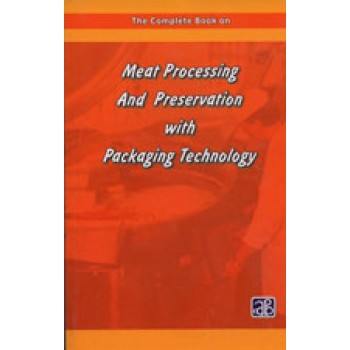The Complete Book on Meat Processing and Preservation with Packaging Technology
| Price: | Rs.1,275.00 |
Detail Of The Complete Book on Meat Processing and Preservation with Packaging Technology
| ISBN | 9788178330310 |
| Pages | 540 |
| Language: | English |
| Product Code: | 1 |
| Size(in cm): | 21*13.5 cm |
| Weight(in grams): | 500(approx) |
Description:
Meat was originally processed to preserve it, but since the various procedures cause so many changes in texture and flavour it is also a means of adding variety to the diet. Processing also provides scope to mix the less desirable parts of the carcass with lean meat and in addition is a means of extending meat supplies by including other foodstuffs such as cereal in the product. Food preservation is a method of maintaining foods at a desired level of properties or nature for their maximum benefits. Preservation usually involves preventing the growth of bacteria, yeasts, fungi, and other micro organisms (although some methods work by introducing bacteria, or fungi to the food), as well as retarding the oxidation of fats which cause rancidity. Today, meat is processed with salt, colour fixing ingredients, and seasonings in order to impart desired palatability traits to intact and comminuted meat products. Products intermediate to these categories are sectioned, or chunked and formed meats. There are various methods for the preservation of meat; curing, dry curing, smoking, canning, freezing dehydration, fat extraction (wet or steam rendering), etc. Meat curing agents include sodium chloride, nitrite, ascorbate or erythorbate and possibly sodium phosphate, sucrose, dextrose, or corn syrup and seasonings. The salt content of processed meats varies 1 to 12%, according to the type of product. Many intact and comminuted, cured meat products are smoked to impart a desirable smoked flavour and colour. The smoking process many also include a drying or cooking cycle, depending on the product. Canned meats may be processed to be commercially sterile or semi preserved. The objective of commercial sterilization is to destroy all harmful bacteria or bacteria that may cause spoilage of the product under normal unrefrigerated storage. However, the process does not kill the spores of all heat resistant bacteria. Frozen meat can be kept at low temperatures for many months. Freezing and subsequent thawing produce changes in the structure of meat that affect its physical properties. If meat is frozen very rapidly at low temperatures, the ice crystals are small and form within the fibers. The drip loss upon thawing is generally greater in slow frozen than in quick frozen meat. Freeze drying meat extends shelf life and reduces weight. The meat is readily defrosted by immersing in water before cooking. Under optimum processing and storage conditions, reconstituted meats have acceptable flavour, colour, texture and nutrient retention.
The meat packing industry handles the slaughtering, processing, packaging, and distribution of animals such as cattle, pigs, sheep and other livestock. The basic purpose of packaging is to protect meat and meat products from undesirable impacts on quality including microbiological and physio chemical alterations. Packaging protects foodstuffs during processing, storage and distribution from contamination by dirt (by contact with surfaces and hands), microorganisms (bacteria, moulds, and yeasts), parasites (mainly insects), toxic substances (chemicals), influences affecting colour, smell and taste (off odour, light, oxygen), loss or uptake of moisture. As such, due to the recent up gradation of preservation techniques, the preservation industry is also growing almost at the same rate as the food industry which is about 10 to 12% per year.
Some of the fundamentals of the book are meat product, simultaneous flavouring and tenderizing, synthetic flavouring, preservation: moisture retention and surface protection, antimicrobial treatment, antioxidant application to freeze dried meats, packaging and handling for storage and transportation, continuous steam cooking of ground meat, activators of natural proteolytic enzymes, isotonic enzyme solution with specific activity, inactivation of enzymes with high pressure, etc.
The origin of meat processing is lost in antiquity but probably began when primitive humans first learned that salt is an effective preservative and that cooking prolongs the keeping quality of fresh meat. This book includes the processing of fresh meats, the different curing agents, method of curing, smoking and manufacturing of various meat products such as sausages, canned meat, cured and smoked meats etc. The book is very useful for entrepreneurs, technocrats and those who want to venture in to this field.
Reviews (0)
Write a review
Your Name:Your Review:
Note: HTML is not translated!
Rating: Bad Good
Enter the code in the box below:



 |
| 